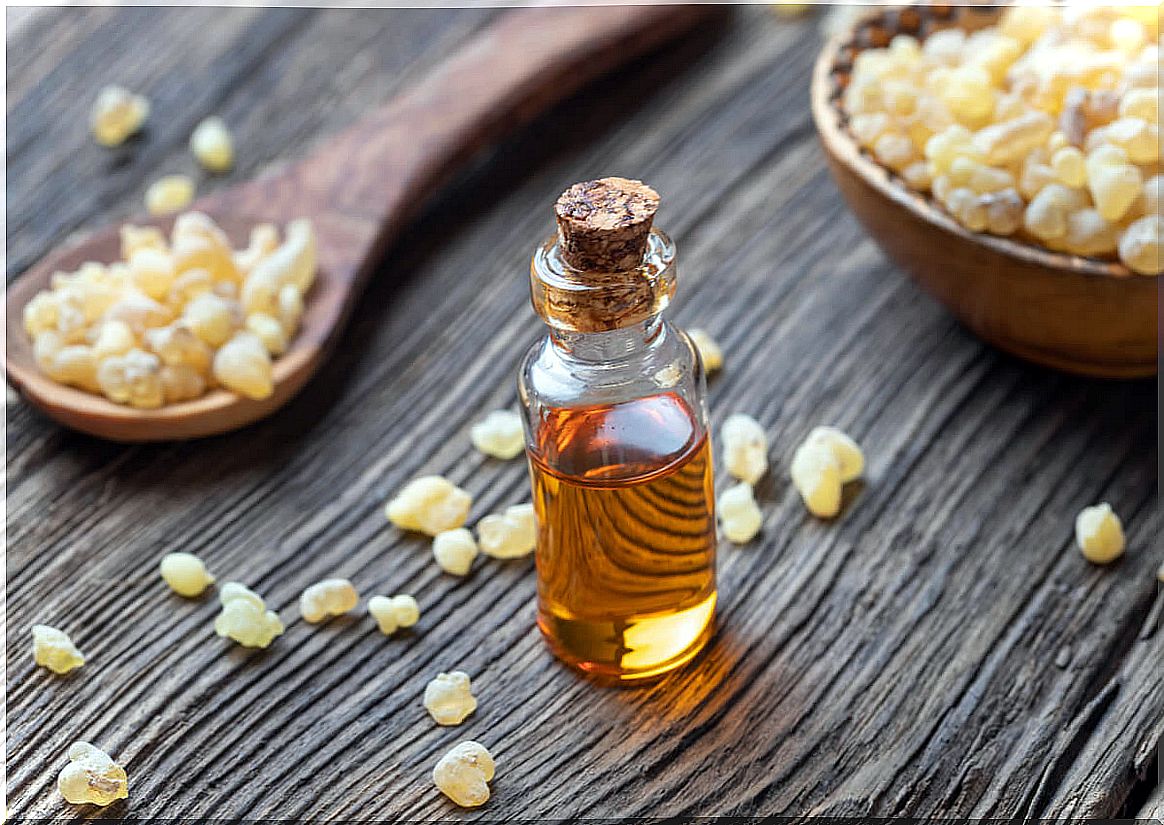What Is Frankincense And What Has It Been Used For?
Frankincense would relieve arthritis symptoms, could control asthma, and its application is being studied in some types of cancer. Find out what it is, how it is used, its benefits and possible adverse effects.

Because of its woody and spicy scent, frankincense is used as incense, food flavoring, and fragrance for perfumes, soaps, and lotions. It is known to be easy to inhale, plus it can be absorbed through the skin.
Frankincense is also considered an Ayurvedic treatment. For hundreds of years, traditional Indian medicine has used it to relieve arthritis pain, improve digestion, and decrease asthma symptoms. For this reason, it can be found in presentations as tea, oil, and supplements. We explain everything you need to know.
What is frankincense?
Frankincense is a resin or organic secretion that is obtained from making cuts in the trunk of Boswellia sacra or frankincense tree. This plant is characterized by having deciduous leaves, a height that ranges between 2 to 8 meters and growing in northeast Africa and the south of the Arabian peninsula.
Similarly, the resin is used as incense, flavoring, and medicine. In the latter case, it is used to treat pain, reduce inflammation and improve wound healing, among others.
What benefits are attributed to it?
The active principles present in the frankincense would confer a series of benefits for human health. Let’s see in detail those that have been certified by science.
1. Could reduce arthritis symptoms
The anti-inflammatory properties of frankincense are linked to a decrease in swelling caused by osteoarthritis and rheumatoid arthritis. According to a study published in Postępy Higieny i Medycyny Doświadczalnej , this is because it interferes with the release of leukotrienes, a group of molecules known to cause inflammation.
It is also a source of terpenes and boswellic acids, compounds known for their anti-inflammatory effects. A test-tube and animal study showed that the effectiveness of these acids is compared to that of non-steroidal anti-inflammatory drugs, but with fewer side effects.
Human research, meanwhile, proposes that frankincense extract is capable of reducing the symptoms of osteoarthritis and rheumatoid arthritis. A 2018 review stated that it is better than placebo when it comes to relieving pain and improving mobility.
Another study found that taking 1 gram of frankincense extract daily for 8 weeks can decrease swelling and pain, as well as increase joint mobility and strength. However, more research is still required.

2. Could improve gut health
For its anti-inflammatory properties, frankincense can benefit the health of the intestine. It is believed to be able to relieve the symptoms of Crohn’s disease and ulcerative colitis. In fact, a study in patients with Crohn’s disease suggested that frankincense extract may decrease the symptoms of this disease in the same way that a specialized drug, such as mesalazine, would.
Additionally, research in people with chronic ulcerative colitis found that taking 900-1050 milligrams of frankincense for 6 weeks could be as effective as a certified drug, but with fewer side effects.
Now, there is scientific evidence that ensures that consuming 1200 milligrams of boswellia can reduce the days of diarrhea in people who have a chronic state. However, more research is needed.
3. It would allow to control asthma
Frankincense has been used traditionally for the treatment of bronchitis. Its active ingredients have been shown to affect the production of leukotrienes, molecules that cause the bronchial muscles to contract during an asthma attack.
Furthermore, in a study with patients who took 300 milligrams of frankincense 3 times a day for 6 weeks, asthmatic symptoms improved in 70% of the participants. Something similar happened in an investigation in which 1.4 milligrams of frankincense were consumed per pound of weight. In general, there was an increase in lung capacity and a reduction in attacks in chronic patients.
Finally, a study published in Phytotherapy Research found that taking 200 milligrams of a Frankincense and Bengal quince supplement could be more effective in reducing asthma symptoms than a placebo substance.
4. It would promote oral health
In folk medicine, frankincense is a powerful remedy against halitosis, toothache, cavities, and sores. This is due, according to research published in BMC Research Notes , to the antibacterial properties of boswellic acids that prevent oral infections.
A test-tube study suggested that frankincense extract may also fight the bacteria Aggregatibacter actinomycetemcomitans, known to be the cause of aggressive periodontitis.
Finally, research in high school students with gingivitis found that chewing gum with 100 to 200 milligrams of frankincense for 3 weeks would reduce gingivitis better than a placebo substance. However, more research in humans is needed.
5. It would fight some types of cancer
According to a study by Oncology Letters , boswellic acids present in frankincense are capable of slowing the spread of cancer cells. Similarly, a 2016 review ensures that these acids can prevent the DNA of this cell type from forming.
As if this were not enough, a test tube investigation showed how frankincense oil can differentiate between normal and malignant cells, killing only the latter. Some scientific evidence claims that it would attack neoplastic cells in the breast, prostate, pancreas, skin, and colon. Although more research in humans is still warranted and cannot be considered a first-line approach, in any way.
Dosage and recommendations for the consumption of frankincense
Since it can be ingested in different ways, a single dose of this substance has not been established. The recommended amounts are based on studies and are usually given through tablets. Research published in the Journal of Herbal Pharmacotherapy recommended the following for use 3 times a day:
- Asthma : 300 to 400 milligrams.
- Crohn’s disease : 1200 milligrams.
- Osteoarthritis : 200 milligrams.
- Rheumatoid arthritis : 200 to 400 milligrams.
- Ulcerative colitis : 350 to 400 milligrams.
- Gingivitis : 100 to 200 milligrams.
However, in the case of creams the recommended dose has not been estimated, but whatever the presentation in which you want to use this substance, it is imperative to consult a doctor.
It should also be known that frankincense is capable of interacting with certain medications, such as anti-inflammatories, anticoagulants, and pills to lower cholesterol levels. This is one more reason to go to a professional before starting a supplementation.
Low toxicity, frankincense is safe for most people. Although an animal study found that doses greater than 900 milligrams per pound can be harmful, this is not known in humans.
Of course, it has been documented that the most common adverse effects are nausea and acid reflux. In addition, there is research that associates it with an increased risk of miscarriage, so its consumption should be avoided during pregnancy.

Other uses of frankincense
In ancient times, frankincense was considered a remedy for everything. Its healing properties were used to relieve menstrual pain, hemorrhoids and even skin cancer.
Currently that has not changed. In the countries where it is produced, such as Oman, the resin is chewed like chewing gum to freshen the breath. Pregnant women also often chew it, as there is a belief that this will make the baby be born intelligent.
In addition, it is added to teas in order to improve digestion and skin health, it is used to perfume homes and ward off mosquitoes, as well as incense to symbolize welcome and hospitality.
Frankincense: From Ayurvedic Medicine to Scientific Studies
Frankincense is a resin obtained by making incisions or tearing the bark of Boswellia sacra into strips . Its applications are varied and include being used as incense, flavoring, perfume and repellent.
In the same way, it is considered an Ayurvedic medicine remedy and science has managed to verify many of the benefits attributed to it. These include reducing arthritis symptoms, controlling asthma attacks, and improving intestinal health.
Regarding adverse effects, it can be considered safe. However, it is best to consult a doctor before starting to take it, especially if you are a pregnant woman.









